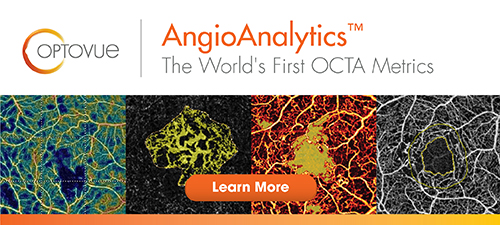FROM THE EDITORS OF REVIEW OF OPHTHALMOLOGY:
Lessons From Recent Phase III Trial Failures
Retinal Volume as OCT Biomarker for Disease Activity in nAMD
Intravitreal Aflibercept for Exudative AMD with Good VA Evaluation of Multispectral Imaging in Diagnosing Diabetic Retinopathy Quantitative Assessment of Macular Contraction & Vitreoretinal Alterations in Anti-VEGF-treated DME Fixation Status After Resolution of Macular Edema Associated with BRVO IVB & Posterior Sub-tenon’s Injection of Triamcinolone Acetonide in ME Secondary to RVO Researchers compared the efficacy and safety between posterior sub-Tenon’s injection of triamcinolone acetonide (PSTA) and intravitreal injection of bevacizumab (Avastin) (IVIA) in the treatment of macular edema secondary to retinal vein occlusion. In the study, the investigators retrospectively studied a total of 45 eyes (23 eyes with intravitreal bevacizumab and 22 eyes with posterior sub-Tenon’s triamcinolone acetonide). Main endpoints included logMAR of best-corrected visual acuity, central macular thickness and intraocular pressure after treatment at six months. At six months, the mean logMAR vision improved from 0.78 (around 20/125) to 0.56 (slightly better than 20/80) for intravitreal bevacizumab (p=0.001), and from 0.91 (about 20/160) to 0.79 and 0.87 at three and six months (p=0.038 and 0.13), respectively, for sub-Tenon’s triamcinolone acetonide. At six months, the BCVA was significantly better in the bevacizumab group (p=0.02). Both groups’ mean CMT significantly improved, from 478 µm at baseline to 295 µm at six months in the IVIA group (p<0.001) and from 419 µm at baseline to 350 µm in the PSTA group (p=0.012); however, this wasn’t different between the groups at six months (p=0.065). Recurrence of macular edema wasn’t different between the groups either (p=0.08). Poorer final vision was associated with poorer baseline BCVA and diagnosis of central retinal vein occlusion after adjustment for age and sex (p<0.001 and 0.012, respectively). Significant elevation of IOP was noted at three months in the PSTA group, but declined at six months compared with baseline (p=0.002 and 0.41, respectively). Intravitreal bevacizumab seemed to achieve better visual acuity compared with posterior sub-Tenon’s injections of triamcinolone acetonide at six months, while CMT was comparable. PSTA still resulted in transient IOP elevation. SOURCE: Tsai MJ, Hsieh YT, Peng YJ, et al. Comparison between intravitreal bevacizumab and posterior sub-tenon injection of triamcinolone acetonide in macular edema secondary to retinal vein occlusion. Clin Ophthalmol 2018;12:1229-35. Molecular Diagnostic Test for Retinitis Pigmentosa In a recent study, researchers noted that retinitis pigmentosa is the most common form of inherited retinal dystrophy caused by different genetic variants and that more than 60 causative genes have been identified to date. They suggested that establishing cost-effective molecular diagnostic tests with high sensitivity and specificity could be beneficial for individuals and clinicians, so they developed a clinical diagnostic test for RP in a Japanese population and evaluated the technology in a prospective, clinical and experimental study. Researchers established a panel of 39 genes reported to cause RP in Japanese patients. They used next-generation sequence technology to analyze 94 probands with RP and RP-related diseases. After interpreting detected genetic variants, a multidisciplinary team of clinicians, researchers and genetic counselors made a molecular diagnosis based on a review of the genetic variants and clinical phenotype. NGS analyses identified 14,343 variants from 94 probands, of which 189 variants from 83 probands (88.3 percent of cases) were found to be pathogenic; 64 probands (68.1 percent) had disease-causing variants. After reviewing the 64 cases, the team made molecular diagnoses in 43 probands (45.7 percent). The final molecular diagnostic rate with the system combining supplemental Sanger sequencing was 47.9 percent (45 of 94 cases). Researchers determined that the RP panel provided a significant advantage in detecting genetic variants with a high molecular diagnostic rate. This type of race-specific, high-throughput genotyping enabled researchers to conduct a cost-effective and clinically useful genetic diagnostic test. SOURCE: Maeda A, Yoshida A, Kawai K, et al. Development of a molecular diagnostic test for retinitis pigmentosa in the Japanese population. Jpn J Ophthalmol 2018; May 21. [Epub ahead of print]. Risk of POAG Following Vitreoretinal Surgery Resolution, Depth of Field and Physician Satisfaction During Digitally Assisted Vitreoretinal Surgery |
||||||||||||||||||
Acucela Data On Emixustat Hydrochloride Apellis’ APL-2 on the Fast Track Apellis Pharmaceuticals announced that the U.S. FDA granted Fast Track designation to the company’s APL-2, a novel inhibitor of complement factor C3, as a next-generation monotherapy for the treatment of patients with geographic atrophy. Apellis plans to initiate a Phase III trial for patients with GA later this year which will consist of two identical, prospective, multicenter, randomized, double-masked, sham-injection controlled studies to assess the efficacy and safety of multiple intravitreal injections of APL-2 in patients with GA. Read more. Source: Apellis Pharmaceuticals, July 2018
AiVita Receives $1.7 million CIRM Grant to Treat Vision Loss AiVita Biomedical announced that the California Institute for Regenerative Medicine awarded the company with $1.7 million in funding to further development of their stem cell-derived three-dimensional retina to treat vision loss. The company's Root Of Sight technology uses three-dimensional retina sheets created from human stem cells, transplanted into the back of the eye, to replace lost retina and improve visual acuity. The forthcoming CIRM-funded study will be conducted in collaboration with the Sue & Bill Gross Stem Cell Research Center at University of California, Irvine, a member of the UCLA-UCI Alpha Stem Cell Clinic. Read more. Source: AiVita Biomedical, July 2018 Foundation Fighting Blindness Urges Congress to Pass Eye-Bonds Legislation The Foundation Fighting Blindness expressed strong support of a bipartisan bill introduced late July 18, 2018, in the U.S. House of Representatives that holds promise for saving and restoring the vision of the adults and children in the United States who are blind or have severely impaired vision from a variety of eye diseases and conditions, including inherited retinal diseases and age-related macular degeneration. The Faster Treatments and Cures for Eye Diseases Act, H.R. 6421 would allow for the creation of Eye-Bonds, and would fund translational research and advance treatments and cures for blindness and other causes of severe vision impairment. Eye-Bonds would finance packages of loans that would total $1 billion for new projects over four years in the pilot phase. Read more. Source: Foundation Fighting Blindness, July 2018 Mobile Retina App Detects Edema and Fluid in OCT Images Houston-based Retina-AI recently released a smartphone app, Fluid Intelligence, that the company says helps users detect macular edema and subretinal fluid on optical coherence tomography scans with “greater than 90-percent accuracy.” Retina-AI says the app can be useful in catching diseases such as diabetic macular edema, wet age-related macular degeneration and edema after retinal vein occlusions. It accomplishes this by using cloud-based, machine-learning AI algorithms. Read more. Source: Retina-AI, July 2018 BioTime Awarded NIH Grant BioTime received a $743,345 grant from the Small Business Innovation Research program of the National Institutes of Health. This award constitutes the second-year funding of a $1.6 million SBIR grant to advance BioTime’s retinal restoration program addressing advanced retinal diseases and injuries. BioTime says that data from the retinal restoration program have shown success in growing complete human three-dimensional retinal tissue derived from the company’s human pluripotent cells and in functional integration for advanced retinal degeneration in proof-of-concept animal models. The technology is being developed to potentially treat or prevent a variety of diseases and injuries leading to blindness. Read more. Source: BioTime, June 2018
ALCON UNVEILS NEXT-GENERATION FORCEPS FOR RETINAL SURGERY MPOD Measurement Earns AMA CPT III Code for Use in Research EyePromise announced that its macular pigment optical density measurement by heterochromatic flicker photometry earned a category III CPT code from the American Medical Association. The code, which doesn’t receive paid reimbursement, is used for data collection and tracking for products or services involved in planned or ongoing research to help researchers substantiate widespread usage and efficacy, the company says. Read more. Source: EyePromise, July 2018 Zeiss Introduces Ophthalmic Laser Visulas Green Zeiss unveiled its next-generation Visulas green photocoagulation laser at the World Ophthalmology Congress in Barcelona. Zeiss says the retinal photocoagulation laser offers more seamless workflow by giving doctors the ability to monitor important treatment settings directly from the eyepiece and a way to change settings while operating a joystick. Integrated data management provides user-specific treatment protocols and a contact lens database for multiple users. Designed as a modular and expandable laser workstation, the laser is available in classic and comfort models, and with a choice of single or dual fiber ports, the company says. Read more. Source: Zeiss, June 2018
Notal Vision Simplifies Customer Onboarding for ForeseeHome AMD Monitoring Program
FDA Accepts NDA Filing for B+L’S Loteprednol Etabonate |
Review of Ophthalmology's® Retina Online is published by the Review Group, a Division of Jobson Medical Information LLC (JMI), 11 Campus Boulevard, Newtown Square, PA 19073. To subscribe to other JMI newsletters or to manage your subscription, click here. To change your email address, reply to this email. Write "change of address" in the subject line. Make sure to provide us with your old and new address. To ensure delivery, please be sure to add reviewophth@jobsonmail.com to your address book or safe senders list. Click here if you do not want to receive future emails from Review of Ophthalmology's Retina Online. |


